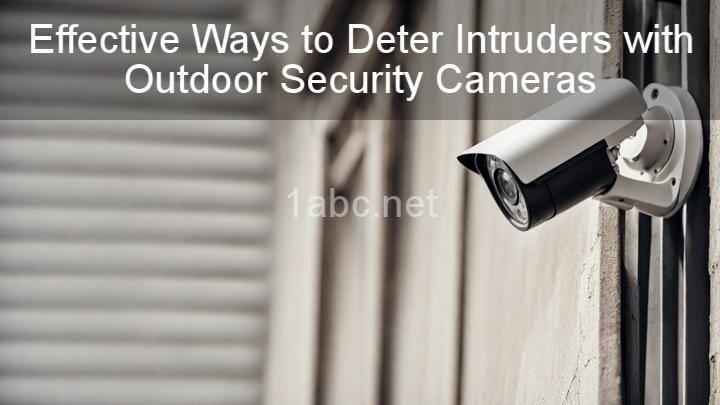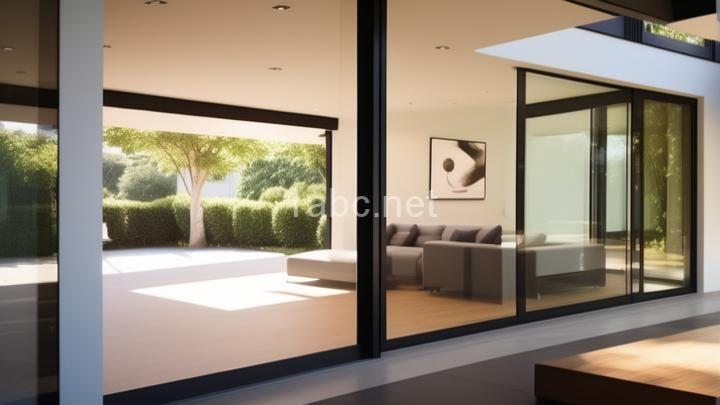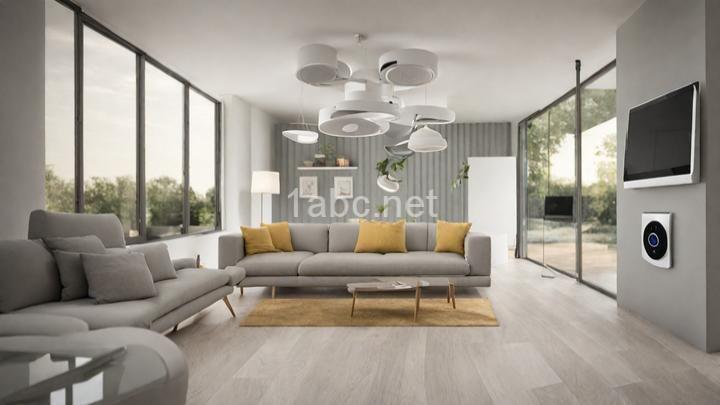Effective Ways to Deter Intruders with Outdoor Security Cameras

Introduction:
Home security is a top priority for homeowners, and outdoor security cameras play a crucial role in deterring intruders. In today's blog post, we will explore the most effective ways to enhance your home security using outdoor security cameras. Our goal is to provide you with valuable information and practical tips to make your home a safer place. So, let's dive right in!
I. Choosing the Right Outdoor Security Camera System
A. Assessing Your Home's Security Needs:
Before investing in an outdoor security camera system, it is essential to assess your home's security needs. Take some time to understand your property layout and identify vulnerable areas that need to be monitored. For example, the front entrance, backyard, and driveway/garage are common areas that require surveillance. By identifying these areas, you can better determine the number and placement of cameras required.
Consider factors such as weather resistance, night vision capabilities, and recording capabilities when selecting an outdoor security camera system. Ensure that the cameras you choose can withstand harsh weather conditions and provide clear footage even in low-light situations.
B. Types of Outdoor Security Cameras:
There are two main types of outdoor security cameras: wired and wireless.
Wired cameras are connected to a power source and transmit data through cables. They offer a reliable and stable connection but may require professional installation. Wireless cameras, on the other hand, are battery-powered and transmit data wirelessly. They are easier to install and can be placed in more discreet locations.
When selecting a camera system, consider the quality and resolution of the cameras. Higher resolution cameras provide clearer images and facilitate better identification of individuals. Additionally, look for cameras with features such as wide-angle lenses and zoom capabilities to capture a broader view of your surroundings.
II. Optimal Placement of Outdoor Security Cameras
A. Key Areas to Cover:
To maximize the effectiveness of your outdoor security cameras, it is crucial to cover key areas of your property.
- Front Entrance: The front entrance is often the primary point of entry for intruders. By installing a camera near your front door, you can deter potential package theft or break-ins. Additionally, having a visible camera at the front entrance will act as a deterrent, discouraging intruders from targeting your home.
- Backyard: Your backyard is another area that requires surveillance. Installing cameras in your backyard helps monitor for trespassers or suspicious activities. It can also serve as evidence in case of any incidents.
- Driveway/Garage: Cameras placed near your driveway or garage can capture license plates or any unusual movements near your vehicles. This information can be valuable in identifying potential intruders or providing evidence in case of theft or vandalism.
B. Strategic Camera Placement Tips:
To ensure optimal coverage and maximize the effectiveness of your outdoor security cameras, consider the following placement tips:
- Install cameras at eye level: Mounting cameras at eye level allows for better facial recognition. This increases the chances of capturing clear images that can be used for identification purposes.
- Avoid obstructions: Ensure that there are no obstructions such as trees, shrubs, or fences that may hinder the camera's view. Clear any potential obstacles that may block the field of vision.
- Consider hiding or conspicuous placement: Depending on your goals, you can choose to either hide your cameras discreetly or place them in visible locations. Visible cameras act as a deterrent, while hidden cameras may capture valuable footage without intruders realizing they are being monitored.
III. Maximizing the Effectiveness of Your Outdoor Security Cameras
A. Proper Lighting Solutions:
Proper lighting plays a crucial role in enhancing the effectiveness of your outdoor security cameras. Consider the following lighting solutions:
- Utilize motion sensor lights: Motion sensor lights are an excellent addition to your outdoor security system. They automatically illuminate dark areas when motion is detected, increasing visibility and deterring potential intruders.
- Combine lighting with cameras: By combining lighting solutions with your outdoor security cameras, you can improve visibility at night. Well-lit areas not only discourage intruders but also ensure that camera footage is clear and useful for identification purposes.
B. Signage as a Deterrent:
Displaying signs indicating the presence of surveillance systems can act as a deterrent to potential intruders. However, it is essential to use friendly language that emphasizes community safety rather than intimidating or threatening language. Signs that indicate the cooperation of the community in maintaining security can create a sense of unity and discourage criminal activity.
IV. Enhancing Overall Home Security Measures
In addition to outdoor security cameras, integrating your home alarm system can further enhance your overall home security. Consider the following benefits of integrating outdoor cameras with existing alarm systems:
- Remote monitoring: By connecting your outdoor cameras to your existing alarm system, you can remotely monitor your property. This allows you to keep an eye on your home even when you are away, providing peace of mind.
- Alerts and notifications: Integrated systems can send alerts and notifications to your phone or email when suspicious activity is detected. This immediate notification allows you to take appropriate action promptly.
V. Ensuring Privacy and Legal Considerations
While outdoor security cameras are a valuable tool in enhancing home security, it is crucial to ensure privacy and comply with local laws and regulations. Familiarize yourself with the following considerations:
A. Familiarize yourself with local laws:
Different regions have specific regulations related to outdoor surveillance. Research and understand the laws and guidelines in your area regarding the installation and usage of outdoor security cameras. Ensure that you comply with these regulations to avoid any legal consequences.
B. Ensure compliance with privacy laws and guidelines:
Respecting privacy is vital when using outdoor security cameras. Avoid placing cameras in areas where privacy is expected, such as bedrooms or bathrooms. Additionally, be mindful of the field of vision of your cameras to minimize intrusion into neighboring properties.
Conclusion:
Enhancing your home security with outdoor security cameras is an effective way to deter intruders and protect your property. In this blog post, we have explored various aspects of outdoor security camera systems, including choosing the right system, optimal camera placement, maximizing effectiveness, integrating with home alarm systems, and ensuring privacy and legal considerations.
By following the tips and recommendations outlined in this blog post, you can significantly enhance your home security measures. Remember, the goal is to create a safe and secure environment for you and your loved ones. Implement these effective ways to deter intruders using outdoor security cameras and enjoy the peace of mind that comes with knowing your home is protected.
We hope you found this blog post informative and helpful. If you have any further questions or need assistance in your home security journey, please feel free to reach out. Stay safe!
FREQUENTLY ASKED QUESTIONS
What are outdoor security cameras?
Outdoor security cameras are devices designed to monitor and record activity outside of buildings or homes. These cameras are typically weatherproof and equipped with features that enable them to withstand various outdoor conditions. Outdoor security cameras can be wired or wireless and may offer a range of functionalities such as high-definition video recording, night vision, motion detection, and remote viewing capabilities. They are commonly used to enhance security, deter criminal activity, and provide surveillance for homes, businesses, and public spaces.
How do outdoor security cameras deter intruders?
Outdoor security cameras can be an effective deterrent to intruders for several reasons:
- Visible presence: The mere presence of security cameras can discourage potential intruders as they know their actions may be recorded. This visual deterrent can make them think twice before attempting any illegal activities.
- Recording evidence: Outdoor security cameras help capture clear footage of any suspicious activities or attempted break-ins. This recorded evidence can be crucial in identifying the intruders and aiding in their apprehension.
- Monitoring in real-time: Many outdoor security cameras provide live video feeds that can be monitored remotely. This allows homeowners or security professionals to keep an eye on their property and take immediate action if any suspicious activity is detected.
- Alarm integration: Some security camera systems can be integrated with alarms or motion sensors. This means that if an intruder is detected, not only will they be caught on camera, but an alarm can sound, alerting neighbors and potentially scaring off the intruder.
- Notification alerts: Many modern outdoor security cameras are equipped with motion detection capabilities. When motion is detected, these cameras can send instant notifications to homeowners' smartphones, allowing them to quickly respond or notify authorities if necessary.
Overall, outdoor security cameras act as a visible deterrent, provide evidence in case of incidents, and can be a valuable tool in preventing break-ins and protecting your property.
What features should I look for in outdoor security cameras?
When looking for outdoor security cameras, there are several important features to consider:
- Weatherproof design: Ensure that the cameras are specifically designed to withstand outdoor elements such as rain, snow, and extreme temperatures.
- High-resolution video: Look for cameras with at least 1080p resolution or higher to ensure clear and detailed video footage.
- Night vision: Opt for cameras with built-in infrared LEDs or other night vision capabilities to capture clear images even in complete darkness.
- Wide-angle lens: Choose cameras with a wide-angle lens to cover a larger area and minimize blind spots.
- Motion detection: Look for cameras that have motion sensors to trigger recording and alerts when any movement is detected.
- Two-way audio: Some cameras offer a built-in microphone and speaker, allowing you to communicate with people near the camera.
- Mobile app integration: Check if the cameras can be accessed and controlled through a mobile app, enabling you to monitor the footage remotely.
- Storage options: Determine if the cameras have local storage options, such as SD cards, or if they rely on cloud storage. Consider the associated costs and limitations.
- Power source: Consider whether the cameras run on batteries, need to be connected to a power outlet, or have the option for both.
- Brand reputation and customer reviews: Research the brand's reputation and read customer reviews to ensure the reliability and performance of the cameras.
Remember to prioritize your specific security needs and budget when selecting outdoor security cameras.
Can outdoor security cameras be accessed remotely?
Yes, outdoor security cameras can be accessed remotely. Most modern outdoor security cameras come with built-in Wi-Fi or Ethernet connectivity which allows them to be accessed and controlled through a smartphone, tablet, or computer from anywhere with an internet connection. This enables users to view live video feeds, receive notifications, and even control certain camera settings remotely. However, it's important to ensure that your security cameras are properly set up and securely configured to protect your privacy and prevent unauthorized access.

